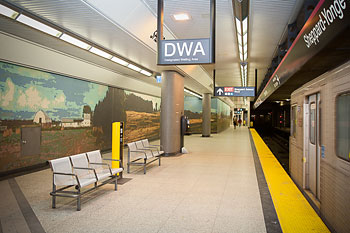Emergency Alarm
The Emergency Alarm should only be used if a customer needs emergency medical, police or fire services.
When the Emergency Alarm is activated, the train proceeds to the next station. Transit Control is made aware of the alarm and notifies 9-1-1.
Whenever an Emergency Alarm is activated, service will be delayed anywhere from two to 20 minutes, depending on the nature or urgency of the incident.
Misuse of the Emergency Alarm can result in a significant fine.
Learn about when and how to use the emergency alarm on subway trains by watching our video, TTC - In case of emergency.
In case of non-emergency
Designated Waiting Areas are located on all station platforms. The DWA is equipped with intercom access to The Customer Service Agent, benches, railing, enhanced lighting, CCTV cameras and a payphone.
Intercoms are in DWAs, in elevator cabs, at elevator landings and on both sides of all fare lines. They let you talk directly to TTC staff who are trained to help customers in non-emergency situations, which helps keep the TTC moving.
